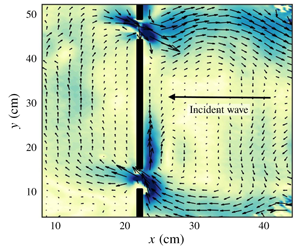No CrossRef data available.
Article contents
An experimental investigation of the Rossby two-slit problem
Published online by Cambridge University Press: 17 April 2020
Abstract

The problem of the transmission of wave energy through small gaps arises in a variety of physical contexts. Here we consider the problem of Rossby waves encountering a barrier with two small gaps. In contrast to waves encountering a barrier with one small gap, in which very little wave energy is predicted to transmit across the barrier, when there are two or more gaps linear theory predicts that the barrier may be surprisingly inefficient at blocking the transmission of Rossby wave energy, owing to the requirement that circulation be conserved around individual segments of the barrier. However, the theory neglects viscosity in the main basin interiors and nonlinear effects in the basins and the gaps. To examine these effects, here we present the results of a series of laboratory experiments in which Rossby basin modes interact with a barrier with zero, one or two gaps. We find that the large-scale waves are able to transmit across the barrier with two gaps as predicted by the theory. However, while the linear theory captures the large-scale flow structures, viscosity and nonlinearity significantly affect the flow along the boundaries and near the gaps in the barrier.
- Type
- JFM Papers
- Information
- Copyright
- © The Author(s), 2020. Published by Cambridge University Press




